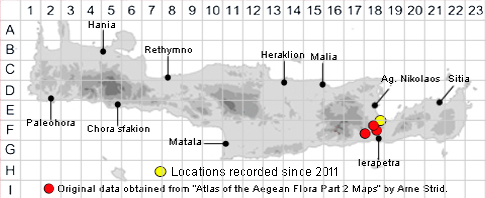
CYNARA CYRENAICA
Family:- COMPOSITAE
Common Names:- None
Synonyms:- None
Meaning:- Cynara (Gr) Dog.
Cyrenaica (L) From Cyrenaica, Libya.
General description:- Perennial herb with enlarged, palisade-like root.
Stems:- Upright with a few branches, height up to 80 cm, width 6-10 mm, with 14 to
20 striations, with short and dense white woolly hairs, glandular.
Leaves:- Few basal leaves forming a level large rosette, petiole short or absent,
lamina with outline broadly elliptical, deeply double lobed, dimensions 30-40 x 20-
30 cm, rachis width 4-9 mm, with short and dense white woolly hairs, main lobes
with narrowly lanceolate outline, secondary lobes extended horizontally and in an
alternating way from the rachis, not straight and forming an angle of about 45? with
it, linear-lanceolate and green on the upper surface, with short and dense white
woolly hairs, slightly glandular on the lower surface, margin twisted, termination
pointed, brown-yellow spine. Stem leaves similar to basal leaves, but shorter and
with lanceolate outline, double lobed on the lower half, simply lobed on the upper
half, 10-30 x 5-10 cm, higher leaves almost without petiole (subsessile), narrowly
lanceolate in outline, simply lobed along their whole length.
Flowers:- Solitary heads at end of stems. Bracts 60-70, in 5-7 rows, leathery, outer
bracts blue-green, moderately to intensely violet, triangular to ovate, 6-8 x c. 3mm,
moderately hairy, sharp tip ending in spine, middle bracts blue-green, frequently
with strong violet tones, sometimes with deep purple spots, broadly longitudinal, 10-
13 x 8-11 mm, slightly hairy to hairless, tip tapered abruptly to a part narrowly
linear, straight, level, length 3-4 cm, ending in a sharp, brown-yellow spine; inner
bracts with shades of brown or red, almost linear, c. 3 cm x 3-3.5 mm, with sharp
tip. Scales of recepticle 2-3 cm. Ray florets 70-80, corolla 3-4 cm x 1-1.5 mm, edge
purple or violet, 1-1.3 cm. Anthers almost white, length 6,5-7,5 mm. Styles purple,
c. 4 cm, with lobes of length 6.5-8 mm. Calyx straw-coloured, wing-shaped,
consisting of 100-150 hard level hairs 2-3 cm x 0.15-0.25 mm, in 3-5 rows.
Fruit:- Mature achenes oval, inflated, length 4-5 mm, black and white.
Key features:-
Habitat:- Slightly to very disturbed ground in limestone substratum. Also in open
sunny places at the edges of olive groves or cultivated fields, in terraces, at the
bottom of ditches and dry stone walls, as well as limestone rocks, sparse bushes
and low growth chiefly of annual herbs. 200-700 m.
Distribution:- Endemic Crete & NE. Libya. Limited distribution on Crete, known
from a very small area between Aghios Nikolaos and Ierapetra in E. Crete. Very
rare.
Flowering time:- May-June
Photos by:- Steve Lenton
FAMILY AND GENUS DESCRIPTIONS
COMPOSITAE
General description:- Herbs or shrubs.
Leaves:- Alternate, opposite or arranged in a rosette (rosulate), exstipulate.
Flowers:- Small (florets), hermaphrodite, functionally male, female, or sterile, in
terminal or axillary, usually stalked (pedunculate) capitula, surrounded by an
involucre of bracts. Capitula solitary or in corymbose, less frequently racemose,
inflorescences. Calyx-limb (pappus) absent or represented by a corona, auricle,
scales, stiff hairs (setae) or simple or softly feathered (plumose) hairs. Corolla of 3
main types: (a) tubular, with (3-)4- to 5-lobed limb, actinomorphic or rarely weakly
zygomorphic; (b) tubular, with a 2-lipped limb; (c) ligulate, with a short tube and the
limb prolonged on one side into a usually 3- or 5-toothed ligule; female florets
sometimes without a corolla or with a thread-like (filiform) corolla. Stamens 5,
united with the petals (epipetalous); anthers usually united (connate) into a tube
round the style, often abruptly ending in a long tail-like or appendage tip (caudate)
or arrowhead-shaped (sagittate) at base and with apical appendages. Ovary inferior,
single-celled (1-locular); ovule solitary, basal, bent parallel to its stalk so the
micropyle is close to the point of funiculus attachment (anatropous); style solitary,
with 2 stigmatic branches.
Fruit:- A cypsela (achene).
The length of the involucre is measured from the base of the capitulum. Pappus-
hairs are described as plumose when the length of the branches is at least 3 times
the diameter of the main hair but much shorter than it.
CYNARA
General description:- Perennial herbs.
Stems:- Erect, striate to ribbed, sometimes absent.
Leaves:- In a basal rosette or alternate, usually deeply divided and with spiny
segments.
Flowers:- Capitula solitary or in a sparingly branched, corymbose cyme. Involucre
ovoid to globose; involucral bracts overlapping (imbricate), glabrous, the outer and
middle with a stout spine or an ovate to triangular appendage at the apex.
Receptacle fleshy, the scales setaceous. Florets all hermaphrodite. Corolla
purplish, blue or white, tubular, 5-fid; style long-exserted.
Fruit:- Achenes obpyramidal or obovoid-cylindrical, glabrous; pappus of many rows
of feathery (plumose), dirty white hairs united (connate) at the base.
Key features:-
1) Receptacle fleshy with scales.
2) Florets subequal.
3) Pappus present, at least partly of plumose hairs.
Sect. CYNARA
Stems:- Present.
Leaves:- Cauline 1- to 2-pinnatifid, with lanceolate to oblong, flat, dentate to
pinnatifid segments.
Flowers:- Involucre ovoid to globose; involucral bracts with a stout, pungent apical
spine or an ovate to triangular, appendage ending abruptly in a sharp point (mucro).
Fruit:- Achenes not winged.
Protection status:-
Listed in "The Red Data Book of Rare and Threatened Plants of Greece" as "VU"
vulerable.
SPECIES DESCRIPTION
